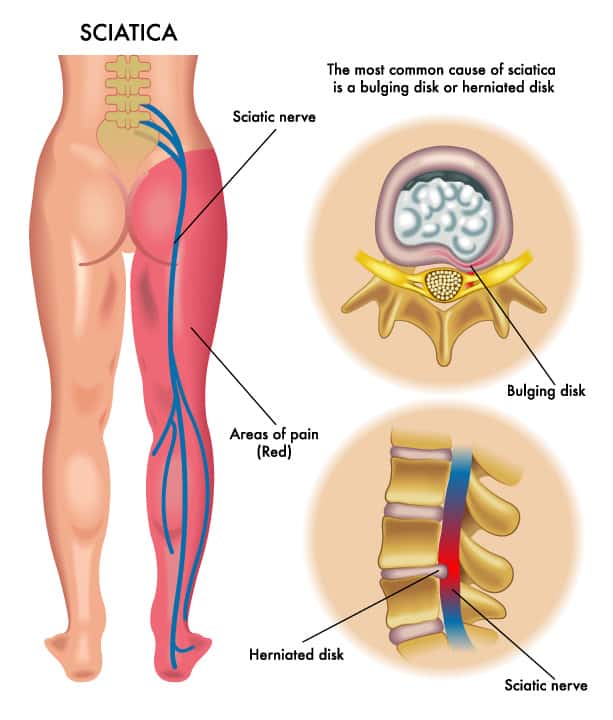Do You Have Sciatica Questions?
Here’s What You Should Know
We’ll start with one of the most common sciatica questions: is stepping out of bed and having pain radiating down my leg sciatica? Or lower back pain that won’t let up? These are symptoms of sciatica, and it can seriously diminish the quality of your life.
Even if you feel the pain in your leg, the issue is normally in your spine. The pain can come and go, but there’s no reason to live with it. Learn more about this condition and how we can help it below. Let’s answering sciatica questions about the nerve itself:
The Basics of the Sciatic Nerve
Your sciatic nerve is the largest single nerve in your body. It starts in the spine of your lower back where it is made up of smaller roots that branch out and then converge to make the sciatic nerve. The sciatic nerve travels through an opening in the pelvis and then below the piriformis muscle. Portions of the sciatic nerve then branch out in each leg to innervate the thigh, calf, foot, and toes.
The size and complexity of this nerve means that nerve pain can have several causes. “Sciatica” isn’t a diagnosis but rather a symptom of an underlying condition. Before we describe the condition, let’s learn more about the pain you may be feeling.
Same Day Appointments Available
Sciatic Nerve Pain
So how do you know if you have sciatica? Most often the symptoms are
- Shooting pain the back of the leg and/or lower back
- Numbness or tingling in your legs
- Trouble moving or staying active
- Stiffness in your feet
- Pain during the night
- Nagging pain after sitting or standing for a long time
The cause of the pain, numbness, tingling, and weakness depends on where the nerve is pinched. For example, symptoms in your foot and ankle indicate nerve impingement near lumbar segment 5 (L5).
5 Answers to Sciatica Questions:
1. Sciatica refers to a set of symptoms
Sciatica is not a condition or diagnosis. The term sciatica refers to a number of symptoms which help lead to a diagnosis. The most common of these symptoms is leg pain, numbness, tingling, or weakness. These symptoms usually affect one leg at a time.
2. Sciatica is well-known, but rare
Many conditions can present the cluster of symptoms that is sciatica. The symptoms of leg pain, tingling, and weakness can be mimicked by piriformis syndrome, hip osteoarthritis, or sacroiliac joint dysfunction.
3. Treating Sciatica Depends on the Underlying Condition
The variety of conditions that can cause sciatic pain makes it essential to accurately diagnose the underlying cause before beginning treatment. Depending on whether sciatica is caused by muscle tightness, disc degeneration, or an anomaly of the hips or spine, the treatment could include physical therapy or interventional pain management.
4. Sciatica Usually Responds Well to Treatment
Once the underlying condition is identified, the symptoms of sciatica usually react favorably to medical treatment without long-term complications. In some cases simple therapy, rest, and rehabilitation will provide long-term relief. In cases of extreme pain, minimally-invasive treatments can help allay severe weakness or numbness.
5. Exercise is Better than Rest
Pain, numbness, and discomfort in your back, hips, and legs may make you inclined to recline – to rest until you feel better. In the cases of sciatica, experts recommend following a structured exercise routine to manage the symptoms and prevent them from returning. Exercise can help correct imbalances and keep joints and spinal discs nourished and flexible.



